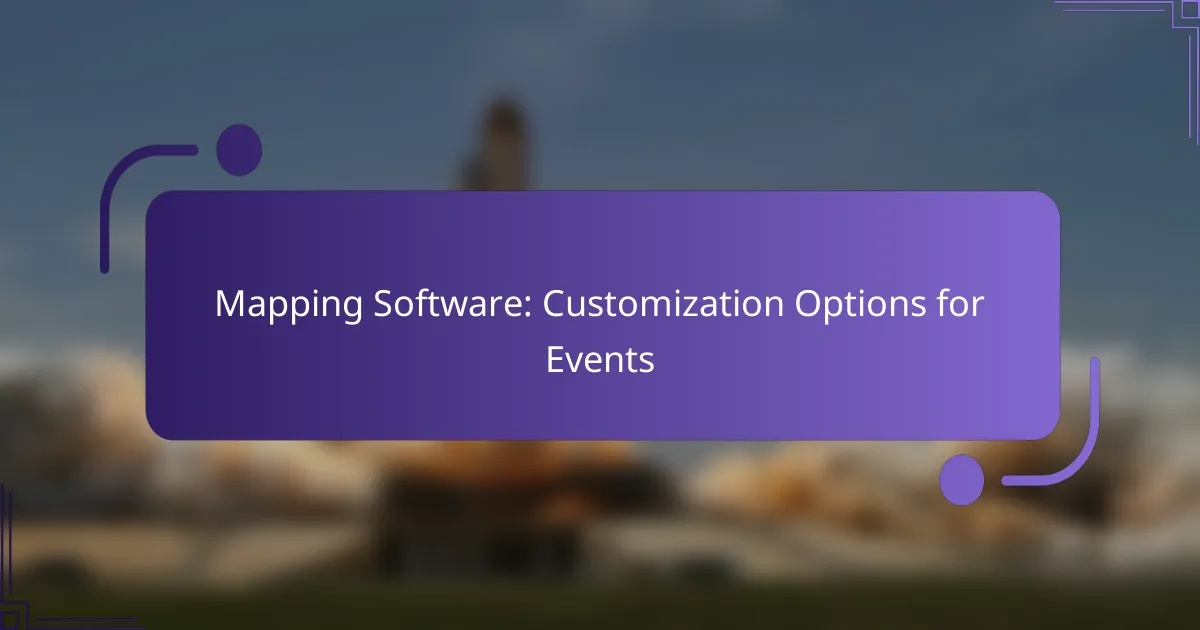Event mapping software provides a range of customization options that allow organizers to tailor the experience to their specific needs. By enhancing visual appeal and interactivity, these tools not only improve attendee satisfaction but also streamline event planning and logistics management.
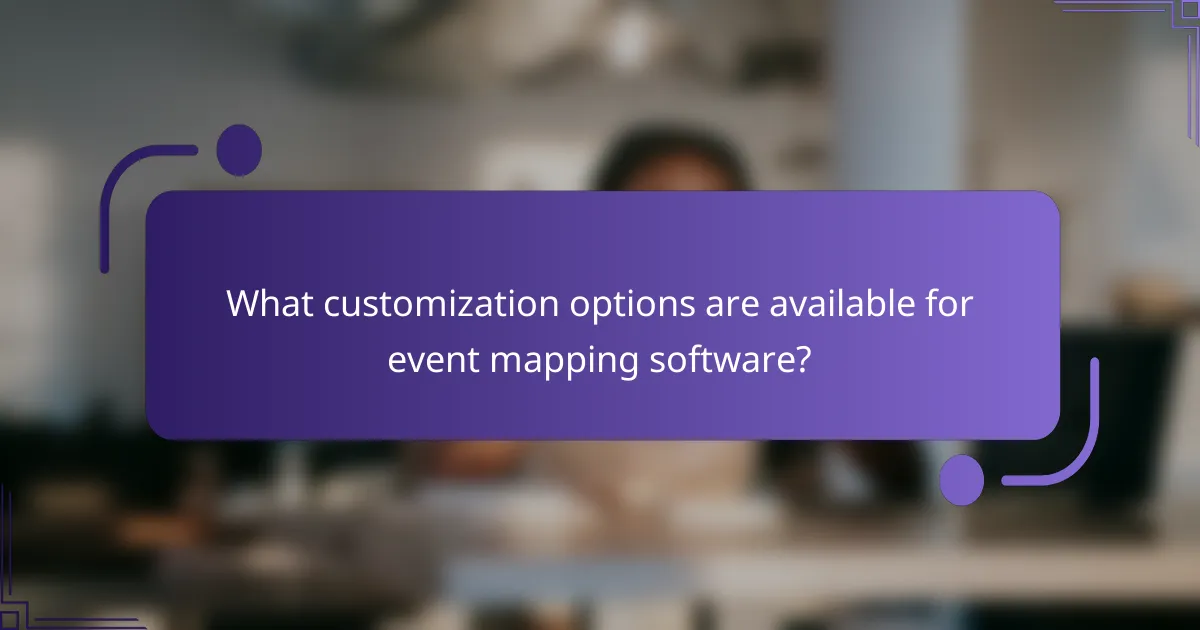
What customization options are available for event mapping software?
Event mapping software offers a variety of customization options to tailor the user experience and functionality to specific event needs. These options enhance the visual appeal, interactivity, and integration of the mapping solution, making it more effective for event planners.
Customizable templates
Customizable templates allow users to select and modify pre-designed layouts that suit their event’s theme and requirements. Users can adjust colors, fonts, and layouts to create a cohesive look that aligns with their branding. Many platforms offer a library of templates that cater to different types of events, from conferences to festivals.
When choosing a template, consider how well it accommodates your event’s unique features, such as booth layouts or seating arrangements. Look for options that allow for easy adjustments to ensure that the final design meets your expectations.
Interactive features
Interactive features enhance user engagement by allowing attendees to interact with the map in real-time. Options may include clickable points of interest, live updates, and navigation tools that help users find their way around the event space. These features can significantly improve the attendee experience by providing essential information at their fingertips.
To maximize the effectiveness of interactive features, ensure they are intuitive and easy to use. Test these features prior to the event to identify any potential issues that could hinder user experience.
Branding options
Branding options enable event organizers to incorporate their logos, color schemes, and other brand elements into the mapping software. This customization helps create a consistent brand presence throughout the event, reinforcing brand recognition among attendees. Many software solutions allow for the addition of custom graphics and promotional materials directly onto the map.
When implementing branding options, ensure that the design remains clear and does not overwhelm the map’s functionality. Balance aesthetics with usability to maintain an effective navigation tool.
Data integration capabilities
Data integration capabilities allow event mapping software to connect with other tools and systems, such as registration platforms and CRM systems. This integration facilitates the seamless transfer of attendee data, enhancing the personalization of the event experience. Users can access real-time information, such as attendee check-ins and session attendance.
Evaluate the compatibility of the mapping software with your existing systems to ensure smooth data flow. Prioritize solutions that offer robust integration options to maximize the benefits of data connectivity.
User permissions settings
User permissions settings provide control over who can access and edit different aspects of the event map. This feature is crucial for maintaining security and ensuring that only authorized personnel can make changes. Organizers can assign roles with varying levels of access to streamline collaboration among team members.
When setting user permissions, clearly define roles and responsibilities to avoid confusion. Regularly review and update permissions as needed to reflect changes in team structure or project requirements.
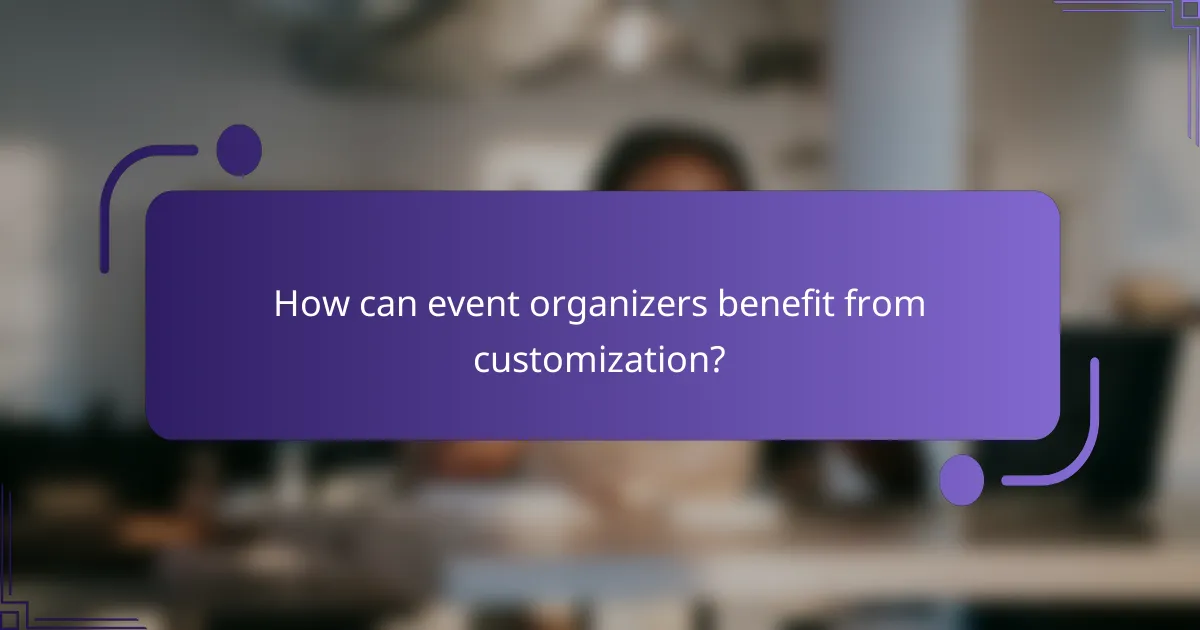
How can event organizers benefit from customization?
Event organizers can significantly enhance their events through customization options in mapping software. Tailoring the event experience to meet specific needs can lead to increased attendee satisfaction and improved operational efficiency.
Enhanced attendee engagement
Customization allows event organizers to create interactive maps that engage attendees more effectively. Features like personalized agendas, location-based notifications, and interactive booths can draw attendees in and encourage exploration of the event space.
For instance, integrating gamification elements, such as scavenger hunts or points for visiting certain areas, can motivate attendees to engage with the event more fully. This not only enhances their experience but also fosters networking opportunities.
Improved event branding
Custom maps can reflect the event’s branding, reinforcing its identity and message. By incorporating logos, color schemes, and thematic elements into the mapping software, organizers can create a cohesive visual experience that resonates with attendees.
Moreover, branded maps can serve as marketing tools, as attendees may share their experiences on social media, further promoting the event. Ensuring that the map aligns with the overall branding strategy can enhance recognition and recall among participants.
Streamlined event management
Customization in mapping software can simplify event management by providing real-time data on attendee movement and engagement. Organizers can track which areas are most visited and adjust resources accordingly, optimizing staffing and logistics.
Additionally, features like emergency exit routes and accessibility options can be integrated into the maps, ensuring safety and compliance with local regulations. This proactive approach to event management can prevent issues and enhance the overall experience for both organizers and attendees.
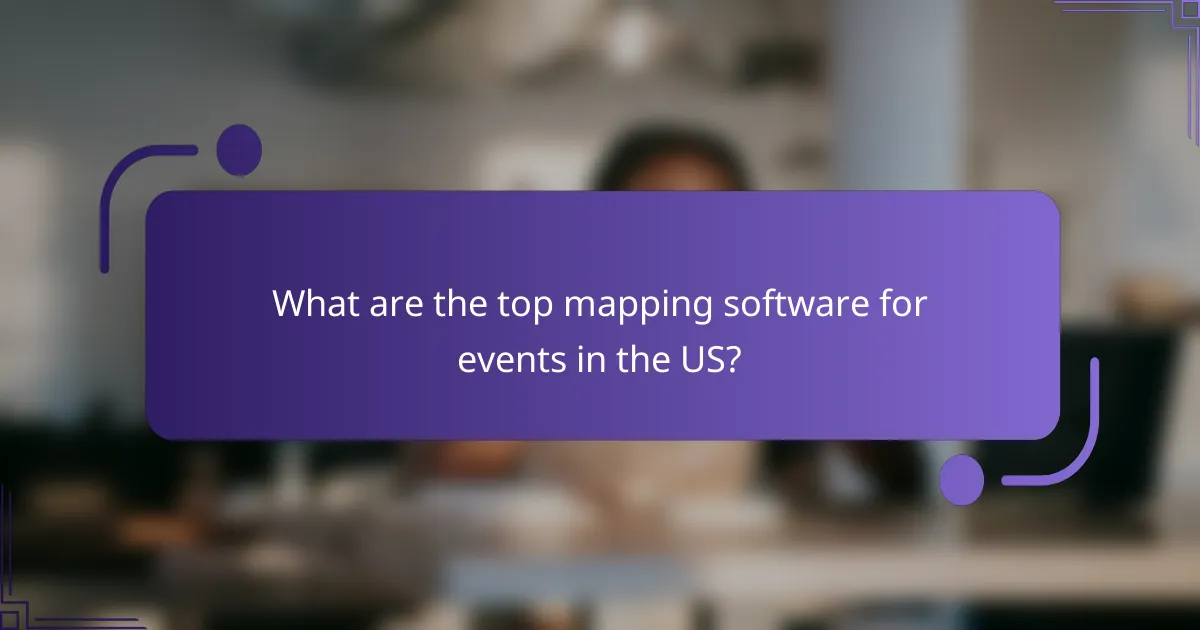
What are the top mapping software for events in the US?
The leading mapping software for events in the US includes platforms that offer customizable features to enhance attendee experience and streamline event planning. These tools allow organizers to create interactive maps, manage logistics, and improve navigation for participants.
Eventbrite
Eventbrite is a popular choice for event organizers, providing a user-friendly interface for creating and managing events. It includes customizable mapping features that allow users to design event layouts, including seating arrangements and vendor locations.
One of the key advantages of Eventbrite is its integration with ticketing and registration systems, which helps streamline the event process. Consider using its mobile app for real-time updates and navigation assistance during the event.
Cvent
Cvent is a comprehensive event management platform that offers advanced mapping capabilities tailored for larger events and conferences. It allows users to create detailed floor plans and interactive maps that can be accessed via mobile devices.
When using Cvent, take advantage of its analytics tools to track attendee movement and engagement. This data can help improve future events by identifying popular areas and optimizing layouts.
Mapify
Mapify specializes in creating visually appealing and interactive maps for events, making it ideal for festivals and outdoor gatherings. Users can customize maps with various markers, paths, and information layers to enhance the attendee experience.
Consider using Mapify’s social media integration to encourage attendees to share their experiences and locations on platforms like Instagram. This can increase engagement and promote your event organically.
Whova
Whova is an all-in-one event management solution that includes robust mapping features for both in-person and virtual events. It allows organizers to create interactive maps that guide attendees to sessions, booths, and networking areas.
Utilize Whova’s attendee engagement tools, such as Q&A and polling, to enhance interaction during sessions. This can help create a more dynamic event atmosphere and encourage participation.
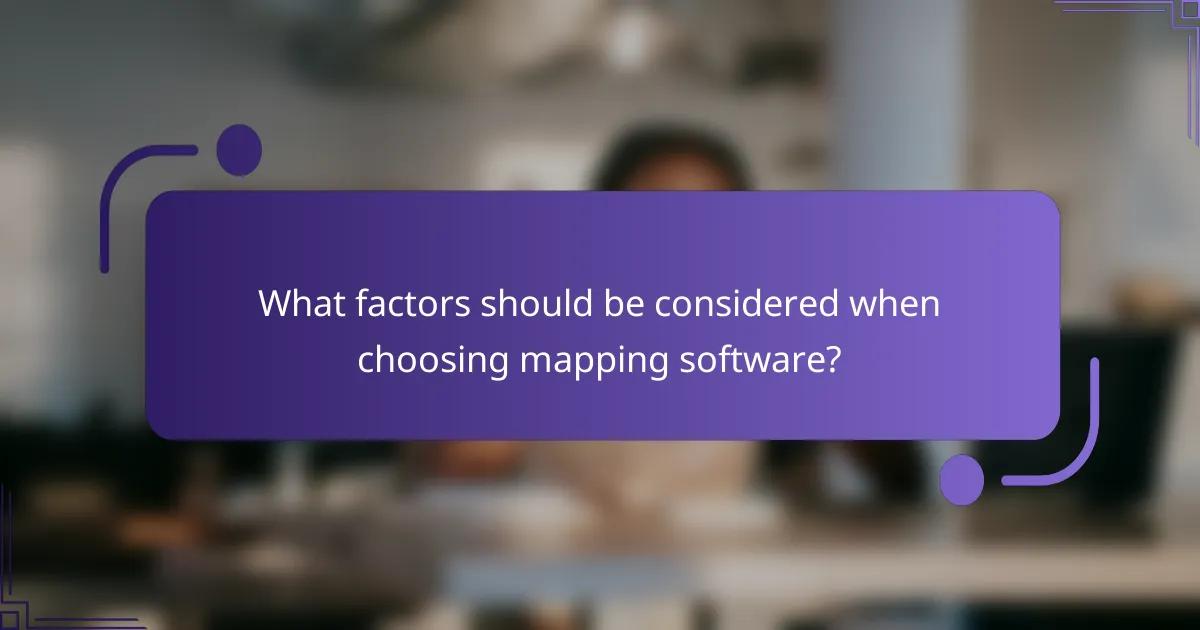
What factors should be considered when choosing mapping software?
When selecting mapping software, consider factors such as budget, scalability, user-friendliness, and customer support. These elements can significantly impact the software’s effectiveness for your specific event needs.
Budget constraints
Budget constraints play a crucial role in choosing mapping software. Determine how much you can allocate for software, including any ongoing subscription fees or one-time purchase costs. Many options range from free basic versions to premium services that can cost hundreds of dollars per month.
Evaluate the features offered at different price points. Sometimes, a more affordable option may provide all the necessary functionalities without the extra costs associated with premium features you may not use.
Scalability options
Scalability options are essential if you anticipate growth in your events. Choose software that can handle an increasing number of users or larger datasets without compromising performance. Look for solutions that allow you to upgrade easily as your needs change.
Consider whether the software can integrate with other tools or platforms you may use in the future. This flexibility can save time and resources as your event requirements evolve.
User-friendliness
User-friendliness is vital for ensuring that all team members can effectively utilize the mapping software. A clean interface, intuitive navigation, and clear instructions can significantly reduce the learning curve. Opt for software that offers a trial period to assess its usability before committing.
Gather feedback from potential users within your organization to understand their preferences. This collaborative approach can help identify software that meets the needs of all stakeholders involved in event planning.
Customer support availability
Customer support availability can make a significant difference when issues arise. Look for mapping software that offers responsive support channels, such as live chat, email, or phone assistance. Check user reviews to gauge the quality of customer service provided.
Consider the support hours and whether they align with your event planning schedule. Having access to timely assistance can prevent minor issues from escalating and ensure a smoother event experience.
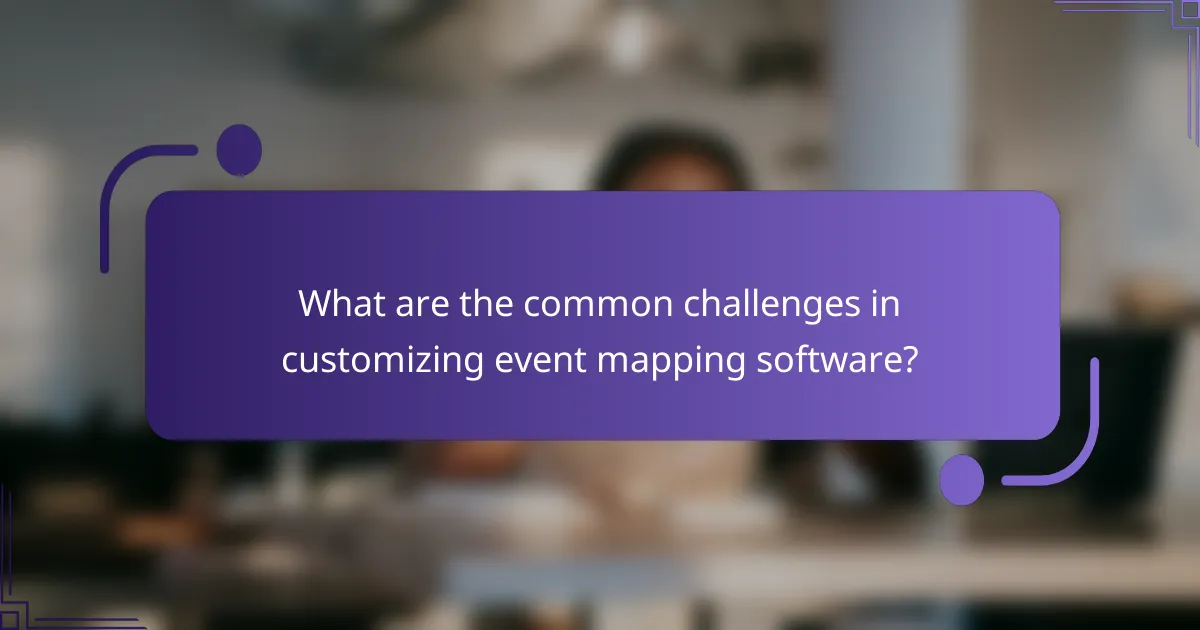
What are the common challenges in customizing event mapping software?
Customizing event mapping software often presents challenges such as limited flexibility, integration issues, and user interface complexities. These obstacles can hinder the ability to tailor the software to specific event needs, impacting overall effectiveness.
Limited Flexibility in Features
Many event mapping software solutions come with predefined features that may not fully align with unique event requirements. This limitation can restrict customization options, making it difficult to adapt the software for specific functionalities like attendee tracking or venue layouts.
To address this, assess your event’s specific needs and choose software that offers modular features or customizable templates. Look for platforms that allow you to add or remove functionalities based on your event type.
Integration Issues with Other Tools
Integrating event mapping software with other tools, such as registration systems or CRM platforms, can pose significant challenges. Compatibility issues may arise, leading to data silos or inefficient workflows.
To mitigate these problems, prioritize software that supports common integration standards and APIs. Conduct thorough testing during the setup phase to ensure seamless data flow between systems.
User Interface Complexities
A complex user interface can hinder the effective use of event mapping software, especially for users who are not tech-savvy. If the software is difficult to navigate, it can lead to errors and inefficiencies in event planning.
Choose software with an intuitive design and provide training for your team. Consider platforms that offer user-friendly dashboards and clear instructions to enhance usability and reduce the learning curve.
